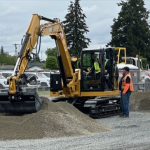Five construction technology trends for 2022
 The new year is right around the corner, and that means it’s time to look toward the future. As 5G expands and internet connectivity increases, a growing number of construction companies are relying on high-tech devices to get things done. Technology is constantly evolving, but we wanted to take a closer look at five technologies expected to transform the world of construction in the coming months.
The new year is right around the corner, and that means it’s time to look toward the future. As 5G expands and internet connectivity increases, a growing number of construction companies are relying on high-tech devices to get things done. Technology is constantly evolving, but we wanted to take a closer look at five technologies expected to transform the world of construction in the coming months.
1) Electronic wearables. The FitBit and Apple Watch have been around for a few years now, but wearables are becoming even more advanced. Currently, there are gloves, vests, hard hats and other types of personal protective equipment that contain wireless sensors and trackers. These sensors can monitor an employee’s every move and make sure they’re practicing proper form (and safety protocols) when using specific tools. What’s more, wearables can monitor vital signs like heart and respiratory rate. If someone slips and falls, they can track that information, as well.
2) Tools powered by artificial intelligence. Thanks to advances in artificial intelligence, robots are becoming more and more capable of routine tasks. Construction companies throughout the U.S. are using robots to unload bricks, tie rebar, paint exteriors and more. Robots don’t get tired, and if they break down, there’s no risk of long-term hospitalization or more serious complications. Most can be controlled remotely, too, so you don’t necessarily have to be on the job site to know what’s going on.
3) Drones. Not too long ago, it took days or even weeks to complete safety inspections on new buildings. Thanks to the rise of drones, the process is much quicker and more affordable. Drones can even monitor construction progress, provide an extra line of security (eyes in the sky) and ensure team members are staying on task.
4) Building information modeling. Building information modeling uses special tools and technologies to design virtual models. These virtual models map the progress of a specific project, from planning and design to construction and operations. By having access to the information you need at each phase of the construction cycle, you can identify inefficiencies, make improvements and ensure the project is finished according to plan.
5) Prefabrication. Thanks to advances in 3D printing, prefabricated construction materials are expected to explode in popularity. Research shows projects that use prefabricated materials typically take half the time to complete and are much more affordable.
Are you using any of these technologies in your current projects? If so, we’d love to hear about your experience. Please visit our Facebook page and leave a comment today.








